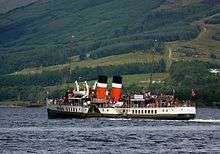Steam power
Steam power was the driving force for much of the Industrial Revolution in the United Kingdom and United States. It brought travel around the world in eighty days within reach of commercial steamship and rail passengers by the late 1800s, while driving the expansion of both transport and industrialization in many parts of the world.
- Steam power is a travel topic.
Understand
While pilgrimages and educational journeys such as the Grand Tour were established before the Age of Steam, it was steam vehicles which made travel a pleasure, and made recreational tourism possible, allowing common people to visit nearby cities and resorts, the middle class to cross the continent, and the wealthiest to travel around the world. The Grand Old Hotels usually trace their history to the Age of Steam.
Most reciprocating steam engines were supplanted by internal combustion engines or electric motors during the 20th century, especially in the decades following World War II. The number of steam trains dropped precipitously, due both to widespread dieselization or electrification of existing rail service and replacement of rail travel by highway travel. Steam turbines remain in common use for a few applications, such as electric power generation. Steam locomotives were held in reserve even in Western countries for a long time due to their ability to run on practically any fuel, but many of those have been sold to enthusiasts or scrapped in the 2000s and 2010s.
Steam railways
- See also: Steam railways, Tourist trains, Travel for rail enthusiasts
While steam is seen with nostalgia or even longing for the "good old days" in places where the last steam service happened some decades past, many developing or emerging economies see the continued existence of any steam locomotives as "backwards" and an embarrassment. West Germany had a next-to-total ban of steam on mainline after the last official steam locomotives were withdrawn. Similar attitudes prevail today in some countries. That said, on marginal or otherwise abandoned lines, steam is still frequently to be seen and there is sometimes even a surcharge on tickets when steam locomotives operate compared to "regular" diesel trains.
Steamers, ships and boats
Before the widespread adoption of commercial air travel in the post-World War II era, mighty ocean liners plied the seas. The Royal Mail Ships of the RMS Titanic era, vying to transport the millionaires of the day, competed aggressively on both speed and luxury.
On inland rivers such as the Mississippi, the distinctive paddle wheel steamboat was once a common sight. A few still operate either as historic restorations or as replicas, imitations of varying accuracy.
Canada
- RMS Segwun, Gravenhurst is a fully-operational restored steamship. Built in 1887, she originally transported vacationers to Muskoka cottages and delivered cargo and mail.
- PS Trillium, Toronto, is a sidewheel paddle steamer which served as a Toronto Islands ferry from 1910-1957. She was restored and returned to service in the Toronto Island Ferry system in 1976.
England
A small number of small steam powered boats continue to operate on Windermere in the English Lake District.
Scotland

- Steamship Sir Walter Scott, Trossachs Pier, Loch Katrine, By Callander, Stirling.
- PS Waverley is the last sea-going paddle steamer in the world. Built in 1946, she sailed on the Firth of Clyde for many years. Since restoration, Waverley has operated regular excursions over the summer. Most are sailing from the Clyde, but there are also some trips up the west coast and Hebrides of Scotland, as well as around the Bristol Channel, Thames and south coast of England.
United States of America
- Belle of Louisville, Louisville, Kentucky is the oldest operating Mississippi River-style steamboat and a National Historic Landmark.
- Ticonderoga, Shelburne (Vermont) is a paddle steamer which served as a Lake Champlain ferry until 1969. Preserved and transported overland to the Shelburne Museum, she is now open for tours.
Static steam engines
The earliest use of steam power for industry was pumping (originally from mines), but large steam engines later become the motive power for all manner of industrial machinery, from textiles, to water supply. A few cities (including Otaru Japan, Vancouver Canada and Saint Helier Jersey) purport to operate a steam-powered clock – or a clock actuating a steam-powered whistle – as a local landmark in some central point in the village.
Canada
- Pump House and Steam Museum, Kingston (Ontario), former steam-powered municipal water pumping station restored in the 1970s
England
- Kew Bridge, Steam museum.
- Bolton Steam Museum.
- Forncett Industrial Steam Museum, Forncett St Mary, Norfolk, England NR16 1JJ, ☎ +44 1508 488277, e-mail: forncettsteammuseum@gmail.com.
Australia
- Cockatoo Island in Sydney is home to a working steam crane that used to be used loading boats.
Steam carousels, gallopers and fairground equipment
Netherlands
England
- Carter's is a touring funfair, with some of the vintage equipment (notably its Gallopers) being steam operated. Operates seasonally, on a touring schedule, so venues vary.